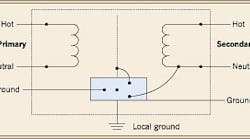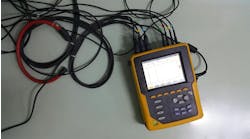In certain instances, system operation problems can be cyclical, many times correlating with utility or facility power system operation. Other times, operational problems are intermittent, coming and going without any pattern or apparent correlation.
The latter usually indicates a wiring and/or grounding problem that allows multiple pathways for circulating electrical noise to exist. As a result, this noise interferes with sensitive signal circuits. Because these circuits may not be protected from such phenomena, the control signals become disrupted or corrupted. This can be the case even in well-designed power distribution systems, such as those having dedicated circuits and shielded isolation transformers feeding electronic control equipment. Let's take a look at an example of such an installation.
Frozen food processor case history
A medium-sized food processing company was experiencing operating problems with conveyor systems that moved product through the preparation process. The conveyors were powered by three 5-hp variable-speed drives that were newly installed. Drive system speed was a function of the level of production. Disturbances to the conveyor systems were so severe that their controls had to be manually reset for production to continue.
The facility manager, being somewhat knowledgeable of the problems associated with the presence of harmonics, believed he had a harmonic interaction on his electrical distribution system, primarily due to the installation of the new nonlinear loads in the form of the variable-speed drives. However, a site inspection revealed that the drives were the only nonlinear loads in the processing area, and a 3,000kVA transformer fed the facility. The small number of nonlinear loads relative to the electrical service size eliminated this as the problem source.
Voltage and current measurements were then taken at the building service entrance, using a true rms measurement device, and found to be well within specified operating parameters and capacity.
Using a harmonic analyzer, current THD of less than 2% was documented. In addition, measurements of individual harmonic distortion (in current) for odd harmonics up to the 21st were taken — each measured less than 3%. A study of the utility distribution system's operation over the prior three months revealed no correlation between its operation and the conveyor shutdowns.
Were isolation transformers doing their job?
Based on the visual inspection, as noted above, it was quite apparent that much thought had been given to the installation, power quality wise. Yet, the facility still experienced conveyor operation problems — it seemed that electrical noise was somehow getting through.
The next step was to verify that the isolation transformers were indeed providing noise rejection and a stable ground reference. Using a true rms multimeter, a voltage measurement was taken between the case of one drive control system and the power system neutral. You would expect a measurement of zero volts at this point but, instead, 35V was measured. Measurements at the other two drives were the same.
Figure 1 shows the proper wiring of these isolation transformers. Notice how the incoming ground, shield, core, and secondary neutral are all bonded at one point. This is called “single point grounding.” This point is then bonded to the building ground system.
When the covers of the transformers were removed to verify their wiring connections, a different grounding scheme was found, as shown in Fig. 2. The neutral was not bonded to the single point ground, and the transformer was not locally grounded to the building system ground. When these missing connections were made, the neutral-to-case ground voltage returned to zero, and the unexplained conveyor upsets ceased to occur.
The above case history shows the difference between a power-related anomaly, which repeats in a cyclical manner, and a disturbance that exhibits random or transitory behavior. Here, the end-user did not think the problem was wiring-related, what with the installation of dedicated circuits and shielded isolation transformers. Mistakenly, the transitory disturbances were attributed to harmonics.



